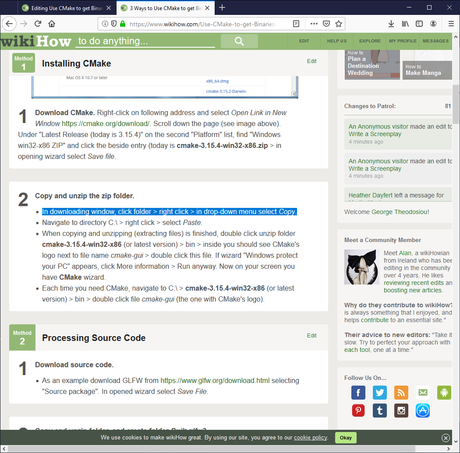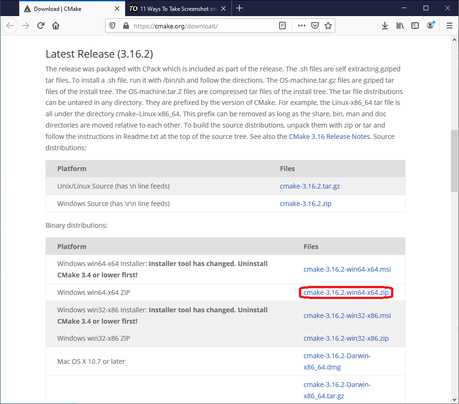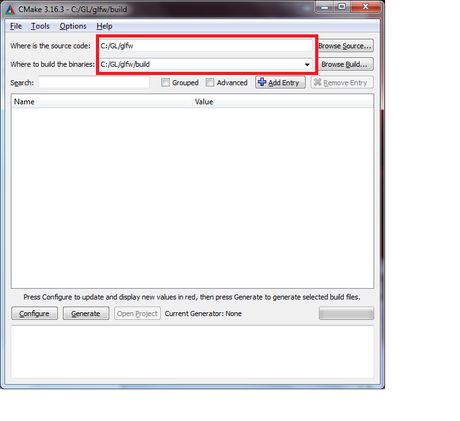How to Use CMake to Get Binaries from Source Code
Method 1 of 3:
Installing CMake
-
 Highlight what you expect to do. For example see picture above.
Highlight what you expect to do. For example see picture above. -
 Download CMake. Right-click on following address and select Open Link in New Window https://cmake.org/download/. Scroll down the page (see image above). Under "Latest Release (today is 3.16.2)" on the second "Platform" list, find "Windows win64-x64.ZIP" and click the beside entry (today is cmake-3.16.2-win64-x64.zip > in opening wizard select Save file.
Download CMake. Right-click on following address and select Open Link in New Window https://cmake.org/download/. Scroll down the page (see image above). Under "Latest Release (today is 3.16.2)" on the second "Platform" list, find "Windows win64-x64.ZIP" and click the beside entry (today is cmake-3.16.2-win64-x64.zip > in opening wizard select Save file. - Copy and unzip the zip folder.
- In downloading window, click folder > right click > in drop-down menu select Copy.
- Navigate to directory C: > right click > select Paste.
- When copying and unzipping (extracting files) is finished, double click unzip folder cmake-3.16.2-win64-x64 (or latest version) > bin > inside you should see CMake's logo next to file name cmake-gui > double click this file. If wizard "Windows protect your PC" appears, click More information > Run anyway. Now on your screen you have CMake GUI.
- Each time you need CMake, navigate to C: > cmake-3.16.2-win64-x64 (or latest version) > bin > double click file cmake-gui (the one with CMake's logo).
Method 2 of 3:
Processing Source Code
- In directory C, create folder GL. In Windows File Explorer navigate to C: > inside, right click > select New > Folder > type: GL > hit ↵ Enter.
- Download source code.
- As an example we use GLFW. Right-click on following address and select Open Link in New Window https://www.glfw.org/download.html. Select "Source package". In opened wizard select Save File.
- Copy and unzip folder.
- In downloading window click zip folder glfw-3.3 (or latest version) > right click > select Copy.
- Navigate to C: > GL > right click > select Paste.
- Now in directory C:GL, you have unzip folder glfw-3.3. Click twice on its name > delete name > type: glfw > hit ↵ Enter.
-
 Where is the source code. In CMake GUI first text field. Copy C:/GL/glfw and paste.
Where is the source code. In CMake GUI first text field. Copy C:/GL/glfw and paste. - Where to build the binaries. In second text field. Copy C:/GL/glfw/build and paste.
- Configure and generate. In CMake GUI, click Configure > in wizard Create Directory click Yes > select Visual Studio 16 2019 > click Finish.
- When, in CMake GUI, you read: "Configuring done", click Generate. You should read: "Generating done".
- Close CMake GUI.
- Build your solution.
- Navigate to C: > GL > glfw > build. Double click "GLFW.sln", or "GLFW", or "ALL_BUILD.vcxproj". An instance of Visual Studio appears. Wait until in main menu Build entry appears. Click it > "Build Solution".
- Wait till you read the last line in "Output" window: ========== Build: XX succeeded, 0 failed, 0 up-to-date, 2 skipped" ==========
- Number XX of "succeeded" changes in glfw versions. Today (31-12-2019) is 32.
- Navigate to C: > GL > glfw > build > src > Debug. Inside you should see file glfw3.lib.
Method 3 of 3:
Testing Binaries
- Create empty project. In V.S. main menu click File > New > Project… > Create a new project > Empty project > Next.
- In Project name text box type: Project-0.
- Next to Location text box, click ....
- Navigate to C: > GL > Click Select a folder. The Location is C:GL.
- Check box Place solution and project in the same directory.
- Click Create.
- Add your source file to the Project. In Solution Explorer wizard, right click the Source Files folder (the last one) > click Add > New Item…
- In the Add New Item - Project-0 window, click C++ File (.cpp) (the first one) from the middle of the window. In the Name text box, type Main.cpp.
- The Location is C:GLProject-0.
- Click the Add button. The file will open in the main text editor but leave it blank for now.
- Configure project's Properties. In Solution Explorer wizard, right click Project's name that is Project-0 > select Properties.
- (1) Project-0 Property Pages main menu. In Platform entry select x64 > click Configuration Manager....
- In Active solution platform: select x64.
- In Platform entry, x64 is automatically selected.
- Click Close.
- (2) Additional Include Directories. Click C/C++ > General > In beside menu select the first one, Additional Include Directories > click the down arrow at the end of the field > click Edit... > first icon > three dots ...
- Navigate to C: > GL > glfw > include > click include > click Select a folder > click OK.
- (3) Additional Library Directories. Double click Linker > click General > Additional Library Directories > click the down arrow at the end of the field > click Edit... > first icon > three dots ....
- Navigate to C: > GL > glfw > build > src > Debug > click Select a folder > click OK.
- (4) Additional Dependencies. In Linker drop-down menu select Input > in beside menu select the first one, Additional Dependencies > click the down arrow at the end of the field > Edit... > copy opengl32.lib; glfw3.lib and paste in Additional Dependencies wizard's upper-most text box > click OK.
- (5) Set System to SubSystem CONSOLE. In Linker drop-down menu select System > in beside menu select the first one, SubSystem > click the down arrow at the end of the field > select Console (/SUBSYSTEM:CONSOLE). Click Apply and OK.
- (1) Project-0 Property Pages main menu. In Platform entry select x64 > click Configuration Manager....
- Test code. Right-click on following address and select Open Link in New Window https://www.glfw.org/docs/3.0/quick.html > scroll down the page to last section: Putting it together: A small GLFW application, and copy code > go to Visual studio and paste it in Main.cpp code area. Hit Ctrl+F5. If everything gone well two windows appear: one black and other with a rotating colored triangle in black background. Good job.
- Correct any errors. In "Error List" if you see error about
- file with extension .h go to Method 3, step 3, sub-step (2) and follow instructions.
- file with extension .lib go Method 3, step 3, sub-step (3), and follow instructions. Also to sub-step (4).
- "entry point must be defined" go to Method 3, step 3, sub-step (5), Set "SubSystem" to "CONSOLE", and follow instructions.
- For other errors, if you can't correct them, close Visual Studio > delete project folder Project-0 which lives in C:GL > open Visual Studio > repeat set up from part Method 2.
4 ★ | 1 Vote



 How to Quick Sort an Array in C++
How to Quick Sort an Array in C++ How to Program in C++ and Batch
How to Program in C++ and Batch How to Create an Alert in C
How to Create an Alert in C How to Calculate Your Wage in C++
How to Calculate Your Wage in C++ How to Set Up SFML in a Project on Visual Studio
How to Set Up SFML in a Project on Visual Studio How to Create Pointers in C
How to Create Pointers in C